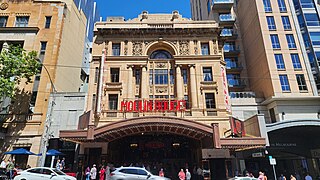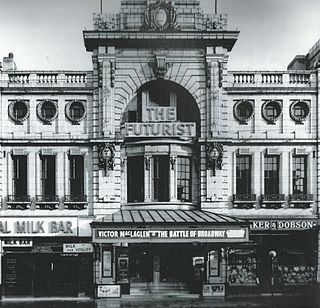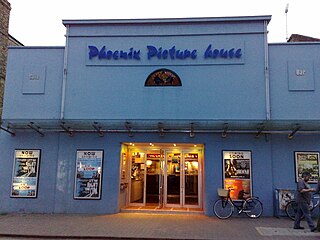
Bill Heine was an American-born British radio broadcaster and writer based in Oxford, England.

Cowley Road is an arterial road in the city of Oxford, England, running southeast from near the city centre at The Plain near Magdalen Bridge, through the inner city area of East Oxford, and to the industrial suburb of Cowley. The central shopping is at 51.746°N 1.232°W

The Regent Theatre is an historic former picture palace built in 1929, closed in 1970, and restored and reopened in 1996 as a live theatre in Collins Street, in the city of Melbourne, Australia. It is one of six city theatres collectively known as Melbourne's East End Theatre District. Designed by Charles Ballantyne in an ornately palatial style, with a Gothic style lobby, Louis XVI style auditorium, and the Spanish Baroque style Plaza Ballroom in the basement, it is listed by the National Trust of Australia and is on the Victorian Heritage Register.
The Whiteladies Picture House is a cinema on Whiteladies Road in Clifton, Bristol, England.

An atmospheric theatre is a type of movie palace design which was popular in the late 1920s. Atmospheric theatres were designed and decorated to evoke the feeling of a particular time and place for patrons, through the use of projectors, architectural elements and ornamentation that evoked a sense of being outdoors. This was intended to make the patron a more active participant in the setting.

John Buckley is an English sculptor whose best known work is the sculpture "Untitled 1986", better known as "the Shark House" or "The Headington Shark" in Headington, a suburb of Oxford.

The Palace Theatre was an entertainment venue located in Melbourne, Australia. First built for live theatre in 1912, it was also used as a cinema and for live music. It was demolished except for its facade in 2020 after much community opposition, to be replaced by a hotel.
Palace Cinemas is an Australian cinema chain that specialises in arthouse and international films.

Cottage Road Cinema is the oldest remaining cinema in continuous use in Leeds, West Yorkshire, England. Situated in the suburb of Headingley, Cottage Road was originally built in 1905 as a garage for the nearby Castle Grove mansion. Local newsreel cameraman Owen Brooks leased the garage with his friend George Reginald 'Reg' Smith and the two converted the building into a cinema, which opened as 'Headingley Picture House' on Monday, 29 July 1912. The cinema changed hands in the late 1930s, ultimately being purchased by Associated Tower Cinemas, who changed its name to Cottage Road Cinema and undertook building work.

Luna Leederville is a cinema complex located at the corner of Oxford and Vincent Streets in Leederville, a suburb of Perth, Western Australia.

John Stanley Coombe Beard FRIBA, known professionally as J. Stanley Beard, was an English architect known for designing many cinemas in and around London.
Bradford Odeon is the name applied to two different cinemas in central Bradford, West Yorkshire, England. One, in Godwin Street, was built in 1930 and survives; the other, in Manchester Road, was built in 1938 and demolished in 1969.

The Futurist Cinema was a cinema located in Lime Street, Liverpool. Opened as Lime Street Picture House in 1912, the cinema operated until closing in 1982. Unable to find a new owner it was left to decline. It was demolished in 2016 after a court battle over the controversial plans for redevelopment of the area.

The Phoenix Picturehouse is a cinema in Oxford, England. It is at 57 Walton Street in the Jericho district of Oxford.
New Farm Cinemas is a cinema at 701 Brunswick Street, New Farm, City of Brisbane, Queensland, Australia. It was first built c. 1921. It is also known as Astor Theatre, Merthyr Picture Palace, and Village Twin Cinema Complex. While not heritage-listed itself, the New Farm Cinemas redevelopment has retained elements of the heritage-listed Village Twin Cinema, which was added to the Queensland Heritage Register on 24 March 2000.

The Grosvenor Picture Palace, now known as the Footage, is a former cinema and current pub at the corner of Grosvenor Street and Oxford Road in Chorlton-on-Medlock, Manchester, United Kingdom. Built in 1913–15, it was the largest cinema outside London in its day. It is now a Stonegate pub.
Girlington is an area in Bradford, West Yorkshire, England. Girlington is located to the west of Bradford city centre. The majority population of Girlington are of South Asian origin in particular Pakistani, Afghan and Bangladeshi.

Roxy Theatre is a heritage-listed former theatre at 65–69 George Street, Parramatta, City of Parramatta, New South Wales, Australia. It was designed by Moore & Dyer in association with Herbert & Wilson. It is also known as Roxy Spanish Theatre, Hoyts Roxy Centre, Village Roxy 3 and The Roxy. It was added to the New South Wales State Heritage Register on 2 April 1999.

The Metro Theater is a defunct movie theater at 2626 Broadway on the Upper West Side of Manhattan in New York City. It was designed by architecture firm Boak and Paris and built between 1932 and 1933. The theater is designed in the Art Deco style and originally contained 550 seats. Although the theater's interior was demolished after it was closed in 2005, the original façade remains intact as of 2023 and is a New York City designated landmark.

The Odeon Theatre is a historic former cinema and live entertainment venue in the city of Hobart, Tasmania, Australia.

















